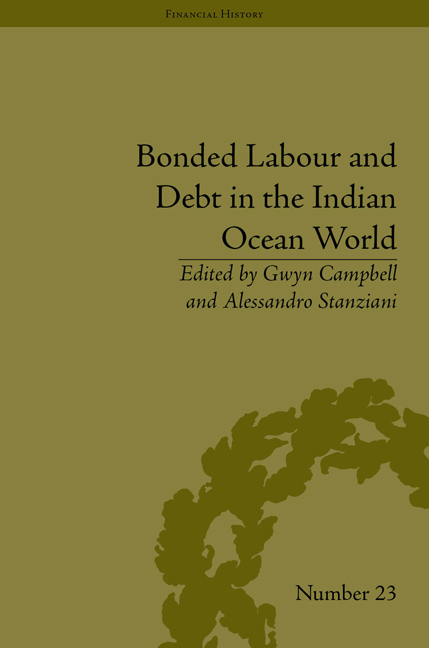Book contents
- Frontmatter
- Contents
- Acknowledgements
- List of Contributors
- Introduction
- 1 Debt and the Coercion of Labour in the Islamic Legal Tradition
- 2 Debt, Pawnship and Slavery in Nineteenth-Century East Africa
- 3 Debt and Slavery in Imperial Madagascar, 1790–1861
- 4 Credit and Debt in the Lives of Freed Slaves at the Cape of Good Hope: The Case of Arnoldus Koevoet, 1697–1735
- 5 Debt, Labour and Bondage: English Servants versus Indentured Immigrants in Mauritius, from the Late Eighteenth to Early Twentieth Century
- 6 Ransom, Escape and Debt Repayment in the Sulu Zone, 1750–1898
- 7 Debt and Slavery among Arabian Gulf Pearl Divers
- 8 The Political Economy of Debt Bondage in Contemporary South India
- 9 The Name of the Slave and the Quality of the Debt: When Slaves Are Not Debtors and Debtors Are Not Slaves in the Family Narrative of a Filipina Comfort Woman
- 10 Two Bonded Labour Emigration Patterns in Mid-Nineteenth-Century Southern China: The Coolie Trade and Emigration to Southeast Asia
- 11 Debt Slaves in Old Korea
- 12 The Debt-Servitude of Prostitutes in Japan during the Edo Period, 1600–1868
- Notes
- Index
Introduction
- Frontmatter
- Contents
- Acknowledgements
- List of Contributors
- Introduction
- 1 Debt and the Coercion of Labour in the Islamic Legal Tradition
- 2 Debt, Pawnship and Slavery in Nineteenth-Century East Africa
- 3 Debt and Slavery in Imperial Madagascar, 1790–1861
- 4 Credit and Debt in the Lives of Freed Slaves at the Cape of Good Hope: The Case of Arnoldus Koevoet, 1697–1735
- 5 Debt, Labour and Bondage: English Servants versus Indentured Immigrants in Mauritius, from the Late Eighteenth to Early Twentieth Century
- 6 Ransom, Escape and Debt Repayment in the Sulu Zone, 1750–1898
- 7 Debt and Slavery among Arabian Gulf Pearl Divers
- 8 The Political Economy of Debt Bondage in Contemporary South India
- 9 The Name of the Slave and the Quality of the Debt: When Slaves Are Not Debtors and Debtors Are Not Slaves in the Family Narrative of a Filipina Comfort Woman
- 10 Two Bonded Labour Emigration Patterns in Mid-Nineteenth-Century Southern China: The Coolie Trade and Emigration to Southeast Asia
- 11 Debt Slaves in Old Korea
- 12 The Debt-Servitude of Prostitutes in Japan during the Edo Period, 1600–1868
- Notes
- Index
Summary
Context
This volume examines the relationship between debt and human bondage in the Indian Ocean world (IOW). The IOW refers to a vast macro region, running from Africa to the Far East, where agricultural production, in which the vast bulk of the population were engaged, and long-distance commercial exchange, notably but not exclusively maritime trade, were largely shaped by the monsoon system. The ‘wet’ (rice) and ‘dry’ (wheat) cultivation regions of Asia were largely dictated by the reach of the monsoon rains, while the monsoon winds (from the south-west during the northern hemisphere summer and from the north-east during its winter), dictated trans-oceanic exchange to the north and to approximately twelve degrees south of the equator. Moreover, terrestrial long-distance trade in regions affected by the monsoons and/or a cyclone season was also largely seasonal, restricted chiefly to the drier winter season.
Human trafficking in the IOW has taken place since at least 2000 bc and experienced three major periods of demand-led acceleration corresponding to sustained bursts of economic growth: from about 200 bc to ad 200, from the ninth to thirteenth centuries, and again from the nineteenth century. In the intervening periods, which were generally characterized by economic stagnation or decline, the slave trade was dominated by supply factors. Systems of bond-age existed throughout the IOW but varied greatly according to time and place. Slavery was limited amongst hunter-gatherer and pastoral peoples, but relatively widespread in sedentary agricultural societies.
- Type
- Chapter
- Information
- Bonded Labour and Debt in the Indian Ocean World , pp. 1 - 20Publisher: Pickering & ChattoFirst published in: 2014



